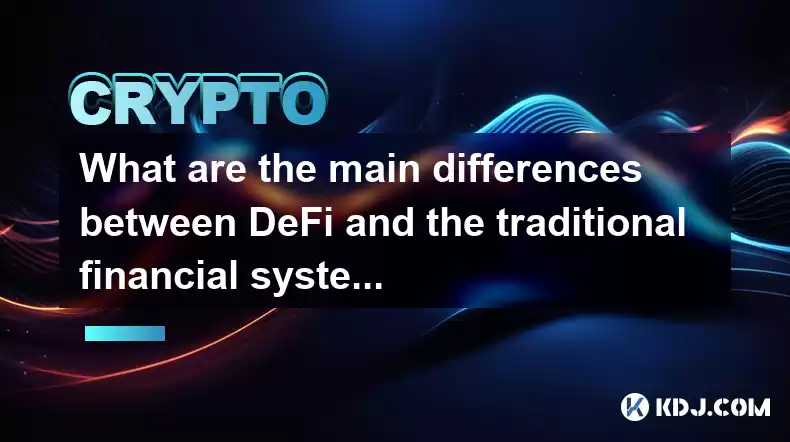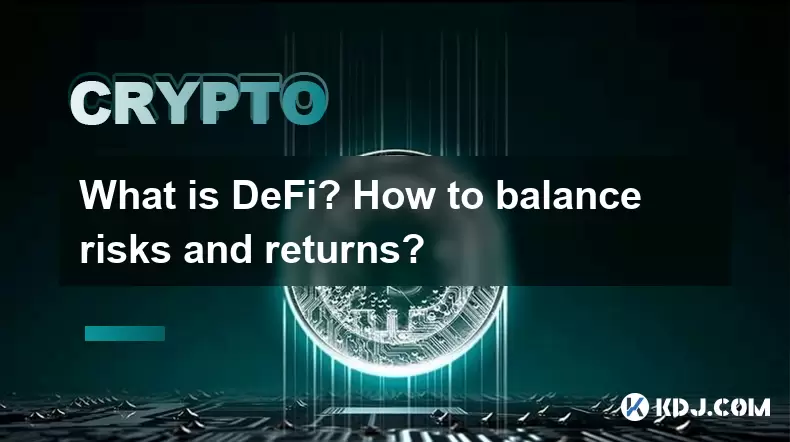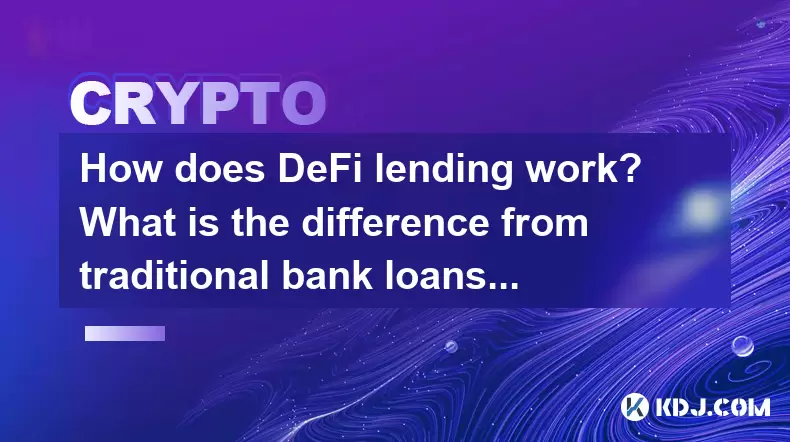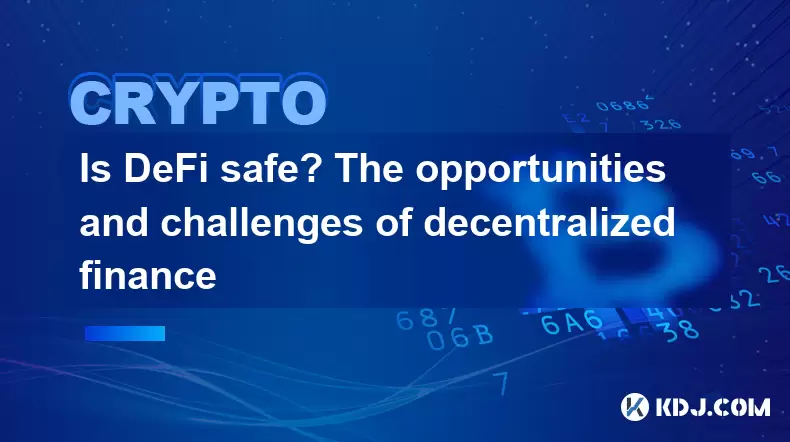-
 bitcoin
bitcoin $122090.672462 USD
1.59% -
 ethereum
ethereum $4493.758974 USD
0.56% -
 xrp
xrp $3.033145 USD
0.65% -
 tether
tether $1.000629 USD
0.00% -
 bnb
bnb $1169.854250 USD
7.07% -
 solana
solana $230.954786 USD
-0.19% -
 usd-coin
usd-coin $0.999785 USD
0.00% -
 dogecoin
dogecoin $0.256108 USD
-1.12% -
 tron
tron $0.342333 USD
-0.12% -
 cardano
cardano $0.859632 USD
-0.10% -
 hyperliquid
hyperliquid $48.932146 USD
-2.25% -
 chainlink
chainlink $22.345466 USD
-1.29% -
 ethena-usde
ethena-usde $1.000217 USD
-0.03% -
 avalanche
avalanche $31.203456 USD
1.93% -
 sui
sui $3.579145 USD
1.05%
What are the main differences between DeFi and the traditional financial system?
DeFi, using decentralized blockchains, offers transparent, accessible finance, contrasting with traditional finance's centralized, opaque, and often exclusionary systems. While DeFi's programmability fosters innovation, it also faces security and regulatory challenges absent in the heavily regulated traditional finance sector.
Mar 13, 2025 at 06:50 pm

- Decentralization: DeFi operates on decentralized blockchain networks, eliminating reliance on central intermediaries like banks. Traditional finance relies heavily on centralized institutions.
- Transparency: DeFi transactions are recorded on public blockchains, offering transparency. Traditional finance often lacks this level of transparency.
- Accessibility: DeFi aims for greater financial inclusion by removing geographical barriers and reducing the need for traditional banking infrastructure. Traditional finance can be inaccessible to many, particularly in underserved communities.
- Security: While DeFi protocols aim for security through code, vulnerabilities and exploits remain a concern. Traditional finance has established regulatory frameworks, but is still susceptible to fraud and systemic risk.
- Regulation: DeFi currently lacks comprehensive global regulation, creating both opportunities and risks. Traditional finance is heavily regulated, offering investor protections but also potentially hindering innovation.
- Interoperability: DeFi protocols are increasingly designed to interact with each other, fostering a more interconnected financial ecosystem. Traditional financial systems often operate in silos.
- Programmability: DeFi utilizes smart contracts to automate financial processes, enabling novel financial products and services. Traditional finance relies on manual processes and complex legal agreements.
The core difference lies in their architecture: DeFi operates on decentralized, permissionless blockchain networks, while traditional finance relies on centralized institutions like banks, brokerages, and governments. This fundamental distinction ripples through every aspect of their operation, impacting accessibility, transparency, security, and regulation.
Decentralization vs. Centralization:DeFi's decentralized nature means no single entity controls the system. This contrasts sharply with traditional finance, where powerful institutions hold significant control over money flows and financial services. The absence of a central authority in DeFi is both its strength and weakness.
Transparency and Privacy:DeFi transactions are typically recorded on public blockchains, enhancing transparency. Anyone can view transactions (although identities might be pseudonymous). Traditional finance maintains a higher degree of privacy, but this can also mask illicit activities. The level of transparency varies considerably between different DeFi protocols and traditional financial institutions.
Accessibility and Inclusion:DeFi aims to broaden financial access by eliminating geographical limitations and reducing reliance on traditional banking infrastructure. Anyone with an internet connection can potentially participate. Traditional finance often excludes underserved populations due to high barriers to entry, stringent KYC/AML requirements, and limited access to financial services in certain regions.
Security and Risk Management:DeFi protocols aim for security through cryptographic mechanisms and smart contracts. However, vulnerabilities in code can be exploited, leading to significant financial losses. Traditional finance employs various security measures, including regulations and oversight, but remains susceptible to fraud, hacking, and systemic risks.
Regulation and Compliance:The decentralized nature of DeFi poses challenges for regulators. A lack of comprehensive global regulations creates both opportunities and risks. Traditional finance is heavily regulated, offering investor protections but also potentially stifling innovation. The regulatory landscape is rapidly evolving for both DeFi and traditional finance.
Interoperability and Integration:DeFi protocols are increasingly designed to interoperate with each other, enabling seamless transfer of assets and creation of complex financial products. Traditional financial systems are often fragmented, with limited interoperability between different institutions and systems.
Programmability and Automation:DeFi leverages smart contracts to automate financial processes, enabling the creation of novel financial products and services. This programmability is a key differentiator, allowing for the creation of decentralized exchanges (DEXs), lending platforms, and other innovative applications. Traditional finance relies heavily on manual processes and complex legal agreements, making innovation slower and more costly.
Speed and Efficiency:DeFi transactions can often be processed faster and more efficiently than traditional financial transactions, particularly cross-border payments. However, network congestion on certain blockchains can impact transaction speeds. Traditional financial systems can be slow and cumbersome, especially when dealing with international transfers.
Common Questions and Answers:Q: Is DeFi safer than traditional finance?A: Neither system is inherently safer. DeFi faces risks from smart contract vulnerabilities and exploits, while traditional finance is susceptible to fraud, systemic risks, and human error. Both have their strengths and weaknesses regarding security.
Q: Is DeFi regulated?A: Currently, DeFi lacks comprehensive global regulation. Regulatory frameworks are evolving rapidly, with different jurisdictions adopting varying approaches. Traditional finance is heavily regulated.
Q: Can I access DeFi from anywhere?A: Generally, yes, provided you have an internet connection and the necessary cryptocurrency wallet. However, access can be limited by geographical restrictions or regulatory hurdles in some regions. Traditional finance access varies significantly based on location and individual circumstances.
Q: How does DeFi compare to traditional banking in terms of fees?A: DeFi transaction fees can vary significantly depending on the network and protocol used. While often lower than traditional banking fees for certain transactions, network congestion can lead to higher fees. Traditional banking fees can be substantial for international transfers and other services.
Q: What are the risks of investing in DeFi?A: Risks include smart contract vulnerabilities, rug pulls (developers abandoning projects), market volatility, and regulatory uncertainty. Traditional finance investments also carry risks, such as market fluctuations, counterparty risk, and inflation.
Q: Is DeFi suitable for everyone?A: No. DeFi requires a certain level of technical understanding and risk tolerance. It's not suitable for everyone, and users should thoroughly research and understand the risks involved before participating. Traditional finance products also have varying levels of risk and suitability for different individuals.
Disclaimer:info@kdj.com
The information provided is not trading advice. kdj.com does not assume any responsibility for any investments made based on the information provided in this article. Cryptocurrencies are highly volatile and it is highly recommended that you invest with caution after thorough research!
If you believe that the content used on this website infringes your copyright, please contact us immediately (info@kdj.com) and we will delete it promptly.
- BlockDAG, DOGE, HYPE Sponsorship: Crypto Trends Shaping 2025
- 2025-10-01 00:25:13
- Deutsche Börse and Circle: A StableCoin Adoption Powerhouse in Europe
- 2025-10-01 00:25:13
- BlockDAG's Presale Buzz: Is It the Crypto to Watch in October 2025?
- 2025-10-01 00:30:13
- Bitcoin, Crypto, and IQ: When Genius Meets Digital Gold?
- 2025-10-01 00:30:13
- Stablecoins, American Innovation, and Wallet Tokens: The Next Frontier
- 2025-10-01 00:35:12
- NBU, Coins, and Crypto in Ukraine: A New Yorker's Take
- 2025-10-01 00:45:14
Related knowledge

How to track DeFi activity on a block explorer
Sep 04,2025 at 05:36pm
Bitcoin's Role in Decentralized Finance1. Bitcoin remains the cornerstone of the cryptocurrency ecosystem, serving as both a store of value and a benc...

What is the difference between DeFi and CeFi? An article analyzing the advantages and disadvantages of both
Jun 13,2025 at 03:57am
Understanding the Foundations of DeFi and CeFiTo fully grasp the difference between DeFi (Decentralized Finance) and CeFi (Centralized Finance), it’s ...

What is DeFi? How to balance risks and returns?
May 31,2025 at 12:22pm
What is DeFi? How to Balance Risks and Returns? Decentralized Finance, commonly known as DeFi, represents a revolutionary shift in the financial ecosy...

How does DeFi lending work? What is the difference from traditional bank loans?
May 29,2025 at 05:36pm
Introduction to DeFi LendingDeFi lending, or decentralized finance lending, represents a revolutionary shift in the way borrowing and lending are cond...

Is DeFi safe? The opportunities and challenges of decentralized finance
May 27,2025 at 02:28pm
Decentralized Finance, commonly known as DeFi, has revolutionized the financial landscape by offering a range of financial services without the need f...

DeFi Mining Tutorial: How to Maximize Profits and Reduce Risks?
May 27,2025 at 07:42am
DeFi, or Decentralized Finance, has opened up a new world of opportunities for crypto enthusiasts looking to maximize their profits through various mi...

How to track DeFi activity on a block explorer
Sep 04,2025 at 05:36pm
Bitcoin's Role in Decentralized Finance1. Bitcoin remains the cornerstone of the cryptocurrency ecosystem, serving as both a store of value and a benc...

What is the difference between DeFi and CeFi? An article analyzing the advantages and disadvantages of both
Jun 13,2025 at 03:57am
Understanding the Foundations of DeFi and CeFiTo fully grasp the difference between DeFi (Decentralized Finance) and CeFi (Centralized Finance), it’s ...

What is DeFi? How to balance risks and returns?
May 31,2025 at 12:22pm
What is DeFi? How to Balance Risks and Returns? Decentralized Finance, commonly known as DeFi, represents a revolutionary shift in the financial ecosy...

How does DeFi lending work? What is the difference from traditional bank loans?
May 29,2025 at 05:36pm
Introduction to DeFi LendingDeFi lending, or decentralized finance lending, represents a revolutionary shift in the way borrowing and lending are cond...

Is DeFi safe? The opportunities and challenges of decentralized finance
May 27,2025 at 02:28pm
Decentralized Finance, commonly known as DeFi, has revolutionized the financial landscape by offering a range of financial services without the need f...

DeFi Mining Tutorial: How to Maximize Profits and Reduce Risks?
May 27,2025 at 07:42am
DeFi, or Decentralized Finance, has opened up a new world of opportunities for crypto enthusiasts looking to maximize their profits through various mi...
See all articles










































































